Envision this: the stage is set, the spotlight cuts through the darkness, and there it is — a stunning spectacle of fire and music intertwined into one art form — a flame maple guitar. There it stands, not just an instrument, but a breathtaking fusion of sonic beauty and visual allure. Suddenly, everything I knew about guitar aesthetics transformed. But the journey is far from complete.
The magic of the flame maple guitar is not merely in its arresting, fiery appearance. Behind the mesmerizing wave patterns of the highly figured wood, there is a fascinating story of craft, science, and most importantly, captivating tonal characteristics. Flame maple isn’t merely a pretty facade; it’s a sonic powerhouse.
As a Berklee-educated music critic and guitar aficionado, my passion for flame maple guitars took root in such moments of awe. I became enraptured with not just how the light dances across their highly figured wood, adding distinct flair to any performance, but also with how they contribute to the rich, vibrant sounds that capture audiences’ hearts. Understanding the allure of flame maple guitars is a quest to decipher the exquisite marriage between aesthetic charisma and acoustic brilliance.
This pursuit has drawn me to investigate the world of flame maples, and the more I uncover, the more I am entranced by the sheer beauty of these musical masterpieces. But what is it that defines flame maple? What lies behind its fiery aesthetics? Together, let’s delve into the world of flame maple guitars, exploring the intricacies of their history, artistry, cultural significance, and perhaps most crucially, how these fiery beauties can elevate your own musical journey.
What is a Flame Maple Guitar?
Defining Flame Maple Wood
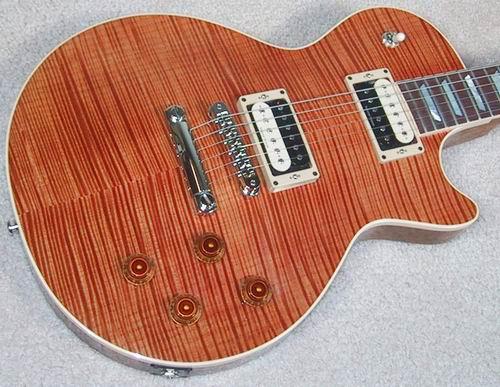
Defining flame maple wood truly brings me back to my early luthiery classes, a memory that is steeped in captivating detail and raw fascination. The intricate patterns of flamed maple tonewood never cease to amaze me, their unique aesthetic and tonal qualities embodying the very soul of a guitar.
Flame Maple, also known as flamed maple, is a species of wood renowned for its distinctive, undulating grain pattern that resembles dancing flames. bookmatched flame maple in specific, wherein two consecutive cuts of the wood are opened like a book, creates incredible visual symmetry and depth, an attribute that guitar builders and enthusiasts alike admire.
The importance of this exceptional tonewood extends far beyond the visual realm, as it plays a significant role in defining a guitar’s sound. Flamemaple belongs to the select circle of elite guitar wood types, contributing not just aesthetics but also tonality to the proud lineage of flame maple guitars. Known for producing a bright, snappy tone and excellent sustain, flame maple is an embodiment of what a high-quality guitar wood should be.
Such is the allure of flame maple. Keenly undefined in its beauty, it remains a perpetual source of inspiration for my craft, a testament to nature’s masterpiece and craftsmanship’s finesse. As we delve further into the world of flame maple guitars, remember that this ethereal wood forms the very essence of what makes these guitars unique, their fiery soul.
History and Significance
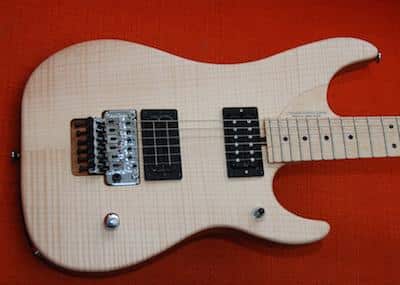
Exploring the past and present contexts of materials like the western bigleaf maple affords an enriching perspective on guitar crafting, accentuating the relevance of the flame maple guitar. As a music enthusiast and mentor, I often dive into this captivating history during gatherings at my luthier supplies workshop.
Evolution of guitars and tonewoods remains a transformative journey. Wherein, the flame maple wood, its exquisite visuals and exceptional acoustic attributes, has significantly molded the narrative. The beautiful hardwood not only provides a guitar with an incomparable character, but its warm and vibrant tonality also plays a vital role, adding life to the meticulous workmanship of instrument crafting.
Traditionally used for back and sides of the guitar, flame maple transitioned into the limelight when luthiers began using it for the top undefined, an innovation that changed the game in the ’50s, and shaped the distinctive sound of many iconic rock, jazz, and blues players in the succeeding decades.
Clearly, this isn’t just another guitar crafting material.
The ‘flame’ reference in the name, suggesting a pattern resonating flames leaping from a bonfire, adds an intriguing mystic element to the western bigleaf maple, amplifying its appeal and popularity amongst players and audience alike. Notably, it remains an enduring embodiment of skilled craftsmanship, artistic vision, and classic tonal quality, encapsulating the timeless essence of music and passion.
The narrative of the flame maple guitar is intertwined with the genre-defining music and pioneering musicians it has produced over the years. Its vibrant history and continued significance further elevate flame maple’s position amongst coveted tonewoods and make it an intriguing topic amongst guitar enthusiasts.
Where Are Flame Maple Guitars Used?

In my many years of involvement in the music scene, both on stage and in the recording studio, I’ve had the privilege of handling an array of guitar types. Among these, the captivating charm and tonal versatility of flame maple guitars have left an indelible imprint. But where exactly does one encounter these flamboyant instruments, and in what contexts do they truly shine?
Electric guitar tops are perhaps the most apparent manifestation of flame maple in the guitar world. Their eye-catching aesthetics and punchy tonal qualities have cemented their status as the staple of rock and roll. You’ll see them in every rock concert, their flaming figures reflecting the vibrant stage lights as musicians play thrilling solos. However, the audio-visual appeal of flame maple transcends the rock genre, and these guitars frequently feature in blues, jazz, and even country performances.
Delight in this thought for a moment—Did you know that the iconic flame maple isn’t only reserved for rock stages but graces the body of intricate acoustic artistry as well? Yes indeed, fire doesn’t discriminate. The flame maple love affair also extends to acoustic guitar flame maple, adding a visual and aural flamboyance to the acoustic world. It’s not just about the breathtaking aesthetics; the tonal coloration and projection of flame maple acoustic guitars fit perfectly into the realm of folk and pop music. Buskers and coffeehouse musicians, in particular, would attest to the standout quality of these radiant instruments.
My wide-ranging experiences have also shown me how the allure of flame maple has influenced custom guitar design. From amateur guitar enthusiasts to professional luthiers, the appeal of flame maple to the artist’s imagination is evident. The unique flame patterns and iridescent qualities offer an exclusive palette for custom design; the wood manages to produce a stunning visual array without sacrificing the guitar’s tonal delivery.
So, whether you’re in a rock concert, watching a street musician, or admiring a custom-made instrument—chances are, the magnetic vibrancy of a flame maple guitar is within arm’s reach. It’s not simply a matter of where these guitars are used; flame maple asserts itself within the larger musical landscape as a ubiquitous expression of style, tone, and craftsmanship united. And each time I come across one, whether on stage, in the studio, or tucked away in an artisan’s workshop, I’m reminded of why I fell for their charm in the first place.
Who Uses Flame Maple Guitars?
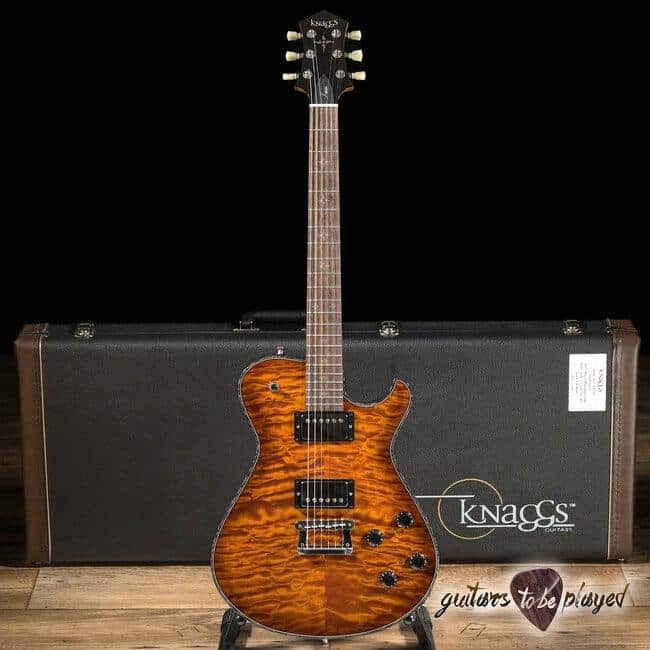
In my journey as a musician, one sight that always leaves a profound impact is the sight of a fellow artist creating magic with the strings of their flame maple guitar. Icons such as Guthrie Govan have used these beautiful instruments to craft sounds that have echoed around the world. Anyone who has had the pleasure of hearing a Guthrie Govan signature guitar in action understands the unique place flame maple holds in the hearts of many legendary guitarists.
Seeing the masterful craftsmanship of these instruments, many up-and-coming musicians and those from the professional league, from diverse genres, have also picked up flame maple guitars. These include musicians who have played Seagull guitars performer editions, which are emerging as a popular choice. Their aesthetic appeal, coupled with their distinctive sound, has made them a beloved pick.
Imagine having the same tonal palette as the guitar virtuosos – flame maple has been at the heart of many historic performances. Once one hears the nuanced, clear notes emanating from brilliant Guild guitars flamed maple series, it becomes evident why these instruments are so adored. The dense grain patterns correspond to the equally dense and complex tonal offerings of these guitars, bringing richness to every performance. From blues to rock to classical strains, the flame maple guitar brings an almost magical quality to the sound.
It’s not just the tone that grabs the interest of musicians; it’s also the gorgeous wave-like, 3D patterns that shimmer under the stage lights, adding an unparalleled visual aspect to the performer’s overall persona. These guitars’ ethereal beauty resonates with their tone, making them a pride of every guitarist’s collection.
Throughout my career, I’ve seen countless artists, from indie rockers to leading jazz musicians, going for flamed maple guitars when they want to deliver an unforgettable performance. Sure, other woods have their charm, but there’s just something about the sound and look of a flame maple that feels very special to us musicians. If you’ve ever strummed a flame maple guitar or seen one being played, you’ll understand exactly what I mean.
And it’s not just professional musicians that find themselves drawn to these beautiful instruments. Hobbyists and semi-professional musicians also prefer them. Despite their relatively higher price tag, their widespread allure stems from a consensus among guitar enthusiasts – a flamed maple guitar is a stunning testament to woodworking skill, craftsmanship and above all, to the rich history and legacy of guitar-making itself. There’s a shared understanding among us musicians about the unique tone and beauty these guitars bring.
Why Choose a Flame Maple Guitar?
Aesthetic Appeal
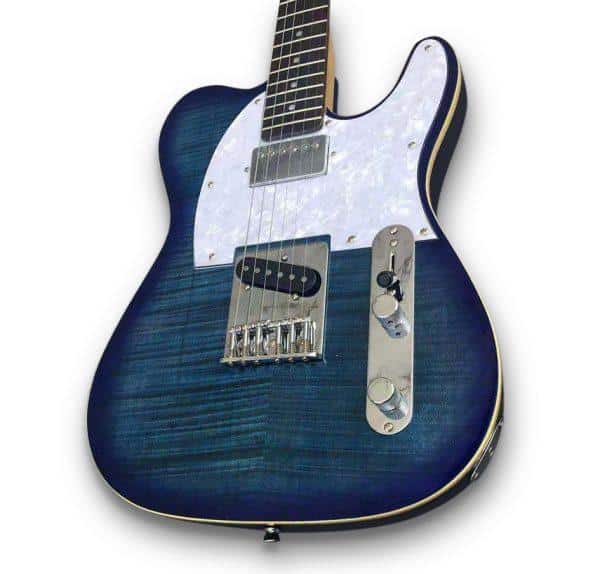
We’ve examined the historical and practical aspects of flame maple guitars, now let’s delve into the element that often captivates one’s initial attention – the aesthetic appeal. The beauty of this tonewood is undeniable and one of the leading reasons many choose a flame maple guitar.
A look at a flame maple guitar and the term “undefined” comes to mind – there’s a remarkable quality to these instruments that makes them both unique and difficult to describe. The shimmering hues and wavy or striped patterns are hallmarks of the flame maple appearance. Each veneer reflecting a fiery character and an unmatched visual appeal.
The aesthetic dimension of flame maple is unmistakable, embodying a pinnacle in guitar wood quality. It’s a feature I often highlight when discussing the visual elements of instruments with my students. The flame maple veneer not just enhances the exterior beauty, but also contributes significantly to the tonal resonance of the guitar, marrying form and function perfectly.
True enough, there’s radiation and warmth to the guitar’s exterior that’s mirrored in the sound it produces – rich, bright, and resonant. It’s not just a guitar you hold, it’s a piece of art, a companion that carries a piece of your aesthetic identity whenever you play.
In conclusion, the decisive factor for many in choosing a flame maple guitar remains its superior aesthetic appeal. It captures your gaze, resonates in your hands, and mirrors the fiery passion of your performance. As we move forward in our exploration of flame maple guitars, we’ll examine sound quality and upkeep to ensure that the spark of this tonewood continues to shine brightly for you.
Sound Quality
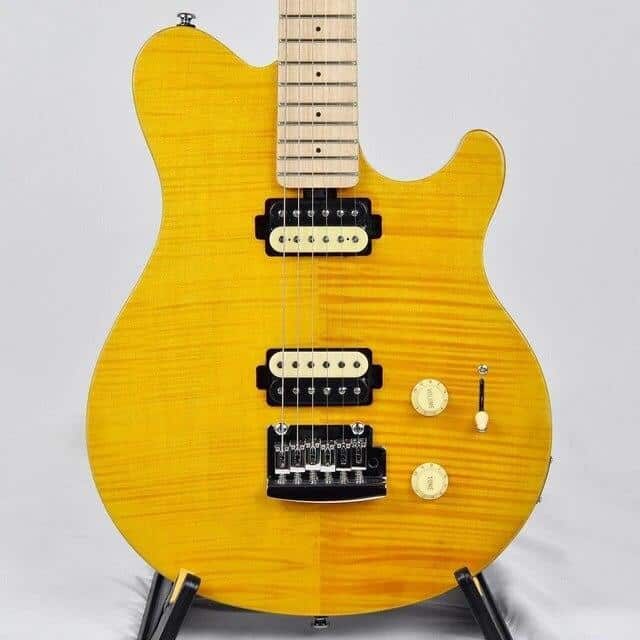
After discussing aesthetics, naturally, we move into what for many is the pivotal reason to choose a flame maple guitar; its distinctive sound quality. The maple guitar sound is incredibly clear; the tones are bright and vibrant, an auditory delight that fills the room. The richness and clarity that the flame maple body wood delivers cannot be overlooked in guitar craftsmanship. Its warm, light timbre adds a unique sonic ambience that set these guitars apart from others.
The choice of guitar body wood significantly influences the overall acoustic and tonal characteristics. In a nutshell, the flame maple durability also contributes to its desirable sound quality. The hardness of the maple plays a key role in shaping the projection and sustain of the guitar, giving a tight, focused sound with a pronounced top end. In contrast to guitars made with softer woods, the flame maple designs produce a more defined and bright note articulation.
Captivatingly, flame maple offers a harmonious balance within tones- a perfect blend of lows, mids, and highs. Its particular density transmits vibrations efficiently, hence contributing to its resonant and lively tone. So, next time when you play those gripping tunes or Smokey blues, remember that it’s not just your passion for music that’s playing out but the astounding physics of flame maple guitars too. As we step into the next section, we’ll learn more about how to identify and care for these beautiful instruments to maintain their outstanding sound and aesthetic appeal.
How to Identify and Care for Flame Maple Guitars
Identifying Quality Flame Maple
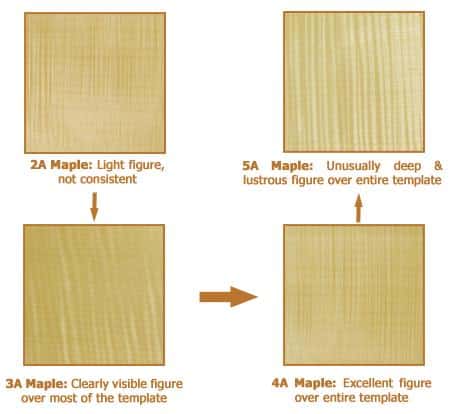
Identifying the quality of flame maple is a key element in the aesthetics and durability of your flame maple guitar. My years of working with these stunning tonewoods have honed my ability to spot a superior-quality flame maple top, a skill I’ve been able to share with countless guitar enthusiasts.
When evaluating flame maple, bear in mind that it’s a highly figured wood. The unique whirls and patterns create its signature flame effect, hence the name. The more intricate and symmetrical these patterns, the higher quality the wood is considered. Amber hues mixed with creamy yellows typify the wood, creating a visual feast akin to a caramelized basswood.
But the appearance is just one aspect. Quality flame maple resonates the guitar’s sound beautifully, deepening the tones without overpowering them. When a note is struck, the top should vibrate uniformly, creating an evenly distributed sound wave that enriches every note.
The undefined fascination with flame maple’s aesthetic and resonating properties has driven many to appreciate the craftsmanship of these guitars. Spotting a quality flame maple top is not just about technical specifications; it goes beyond to reflect your personality and style. Reading the wood, understanding its inherent properties, and connecting to its natural patterns fosters an appreciation deeper than the visual.
Being adept in identifying quality flame maple is a cornerstone for any enthusiast or aspiring guitar craftsman. It’s not simply about owning a flame maple guitar; it’s about cherishing a piece of nature, resonating with its unique traits, creating music soulfully, and echoing that same intimacy in every strum.
Maintenance and Durability

Even the most visually striking guitars, like those made with flame maple, require a determined focus on maintenance to preserve their aesthetic and aural appeal. Over the years, my experience has led me to fine-tune a care routine that ensures the flame maple finish of a guitar retains its radiant beauty and sonic integrity for a lifetime. I can attest to the importance of maintaining a flame maple guitar, because that commitment is inextricable from its durability.
This guitar wood quality, renowned for its stunning flame-like patterns and excellent sound characteristics, is generally sturdy. However, the flame maple’s durability significantly depends on how it’s cared for. Your guitar’s lifespan can dramatically increase if the right maintenance habits are implemented, like using high-quality polishes that are safe for a flame maple finish and maintaining a consistent humidity level where the guitar is stored.
Echoing out from my own experiences, I can tell you that preserving the flame maple’s vibrancy isn’t just for show – it’s a commitment to the instrument’s overall endurance. This is a part of understanding that absolute beauty needs stable care. While the glossy finish and the wavy patterns are a joy to look at, they’re also a testament to the kind of lifeline that active maintenance and considerate handling can provide. So, when you’re strumming a melody on your flame maple guitar, remember that the music and the magic come not just from the natural marvel that is the flame maple but also from the quiet, steadfast care that shields its shine and tone for years.
FAQs
What is flame maple used for in guitars?
How does flame maple affect the tone of a guitar?
What is flame maple’s characteristic look?
Can flame maple be used for both electric and acoustic guitars?
Conclusion
From the timberlands to the guitar stands, the journey of a flame maple guitar is a testament to craftsmanship and musical evolution. Its rise in popularity among renowned musicians and enthusiasts alike is no accident. With their stunning guitar aesthetics, the intrinsic beauty of the flame maple top appeals to the visual senses, while the unique tonewood characteristics shape its vibrant, bright tonal palette.
As a seasoned performer and educator, my personal experience with flame maple guitars has validated their significance. These instruments resonate not only visually but also in the way they craft and color the sound of music, becoming an indispensable part of the guitarist’s tonal repertoire.
If you ask, “Why choose a flame maple guitar?” My answer would always be for its blend of beauty and sound quality. These guitars are more than just visually pleasing objects; they are powerful tools that have shaped and continue to impact the music industry.
Whether you’re a professional musician seeking to diversify your sound, an enthusiast longing for beautiful guitar aesthetics, or a craftsman pursuing top-notch tonewood characteristics, flame maple guitars capture the essence of it all. The guitar, after all, is not just an instrument—it’s an extension of the soul, a lens through which we can express ourselves musically, and in this respect, the flame maple is an exceptional partner.
